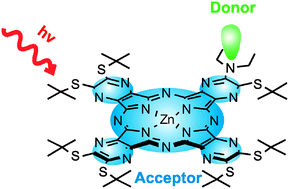Ultrafast intramolecular charge transfer in tetrapyrazinoporphyrazines controls the quantum yields of fluorescence and singlet oxygen†
Abstract
A series of octasubstituted zinc(II) tetrapyrazinoporphyrazines (

* Corresponding authors
a
Department of Pharmaceutical Chemistry and Drug Control, Faculty of Pharmacy in Hradec Kralove, Charles University in Prague, Heyrovskeho 1203, Hradec Kralove, Czech Republic
E-mail:
petr.zimcik@faf.cuni.cz
Fax: +420 495067167
Tel: +420 495067257
b
Institute of Inorganic Chemistry of the Academy of Sciences of the Czech Republic, v.v.i., 250 68 Řež, Czech Republic
E-mail:
lang@iic.cas.cz
c Institute of Physical Biology, University of South Bohemia, Zámek 136, 373 33 Nové Hrady, Czech Republic
A series of octasubstituted zinc(II) tetrapyrazinoporphyrazines (

 Please wait while we load your content...
Something went wrong. Try again?
Please wait while we load your content...
Something went wrong. Try again?
V. Novakova, P. Zimcik, M. Miletin, L. Vachova, K. Kopecky, K. Lang, P. Chábera and T. Polívka, Phys. Chem. Chem. Phys., 2010, 12, 2555 DOI: 10.1039/B918546A
To request permission to reproduce material from this article, please go to the Copyright Clearance Center request page.
If you are an author contributing to an RSC publication, you do not need to request permission provided correct acknowledgement is given.
If you are the author of this article, you do not need to request permission to reproduce figures and diagrams provided correct acknowledgement is given. If you want to reproduce the whole article in a third-party publication (excluding your thesis/dissertation for which permission is not required) please go to the Copyright Clearance Center request page.
Read more about how to correctly acknowledge RSC content.
 Fetching data from CrossRef.
Fetching data from CrossRef.
This may take some time to load.
Loading related content
